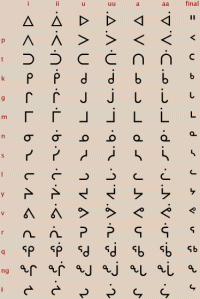 Up here, the sole language of instruction in school is in Inuktitut until grade three, when students are introduced to English. The written language of Inuktitut was developed by missionaries in the late 1800s with syllabics to interpret the language. Before, the Inuit had a rich oral tradition, passed on from elders to their children, perfected over the generations of families living together.
Up here, the sole language of instruction in school is in Inuktitut until grade three, when students are introduced to English. The written language of Inuktitut was developed by missionaries in the late 1800s with syllabics to interpret the language. Before, the Inuit had a rich oral tradition, passed on from elders to their children, perfected over the generations of families living together.
I can see the frustration the children are faced with. The syllabic for what looks like the Latin “b” is sounded as “ku”; “d” as “ka”, “L” is “ma”, and “C” is sounded as “ta.”
In grade three, the students need to relearn the accustomed sounds from syllabics to Latin script.
I have noticed that several Northern publications offer readers a choice of reading articles in English, Inuktitut (syllabic), or Inuktitut (Latin). Greenland, for instance, has done away with syllabics, has officially adopted the Latin script. I think it would be easier for students to make the transition, already being accustomed to the sounds of vowels and consonants. It is enriching to learn of your culture and speak the language of the elders, and as many more languages as you are willing to learn.
However, Syllabics are not part of the Inuit culture. The language was developed by Europeans. Would it make sense to do away with syllabics and use Latin lettering? I believe the students would be less frustrated and would have greater success at school, instead of struggling with ABC’s in grade three.
The following is only for those interested in education: I am continually amazed at the cleverness of my students. I have never worked in the educational field, and am amazed everyday at the improvisation of the grade three/four students in learning their ABC’s, reading, and multiplications.
One of the students I occasionally work is in grade three, but has never been to school, ever. Another student has only been to school sporadically. The first boy is still learning his alphabet with flash cards. He has a lot of problems recognizing the letters and simple sight words. But he does know his “ABC’s” by rote – possible courtesy of Sesame Street. When I gave him a letter to identify, he would walk to the blackboard where a banner of letters of the alphabet has been tacked up. He would identify the shape of the letter and count it out. For instance, if presented with the letter “C”, he would go to the banner and find the letter and then count A … B … C and triumphantly call out “C”
The other boy cannot yet count to 20. He’s never learned, but can do simple multiplication by drawing circles and making marks in each circle. But he is still stuck with counting. How he always came up with the right answer was a mystery, until I saw him counting on a ruler taped to his desk with numbering. He would count with his finger on the ruler, and one finger one on his paper until he reached the right number, for instance 2 x 3 = 6. He could do multiplications that went up to 20 (as per ruler) but did not know the names of the numbers. This would have normally been learned in grades one and two, but here kids can disappear for months to go to camp or stay with relatives in other fly-in communities, or just stay at home.
I am learning so much by watching the inventiveness of the kids.

It is rather late to start with ABC in Gr. 3. Quebec has finally realized that it is best to start the other language (French or English) in Gr. 1. And students there don’t have to learn a different alphabet. I saw the difficulty Yana and Anya had when they came to us from Russia where the Cyrillic alphabet is used. It took me weeks to learn that alphabet! My advanced age was no help, of course.
It is very confusing, and not necessary. The Latin alphabet is already used for Inuktitut in journals and magazines. It just makes so much more sense.